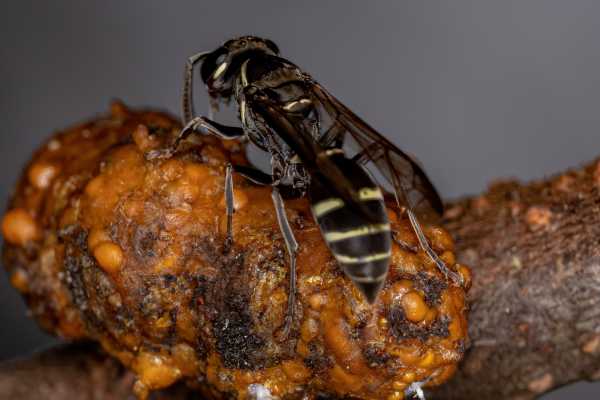How Do Gall Wasps Make Galls?
Gall wasps are a fascinating group of wasps, commonly associated with round, smooth or knobbly galls that appear on oaks.
There are a number of species of wasp (in several genera within the ‘Cynipidae’ superfamily) that create galls.
However, the appearance of galls is varied, as is the host plant. Here we'll look at how galls are made, and also some of the less commonly known types of wasp gall.
How Do Gall Wasps Make Galls?
There are around 1,400 recognised species of gall wasp1. Galls found on oaks, beeches or roses are usually related to gall wasp activity.
However, galls are not only induced by wasps, or indeed other insects. The production of galls can result from mites, viruses, fungi, bacteria and nematode worms.
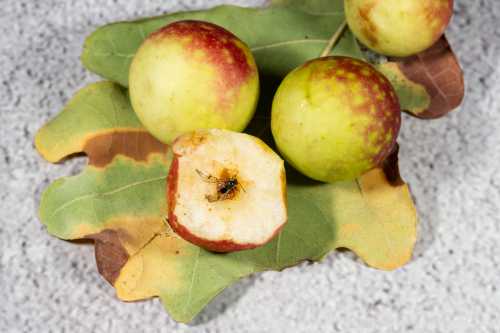 Oak cherry galls caused by activity of a gall wasp, Cynips species.
Oak cherry galls caused by activity of a gall wasp, Cynips species.How wasp oak galls and other galls are formed
Galls associated with gall wasps occur in response to the laying of an egg by the egg-laying female wasp, after she has inserted an egg into a stem, bud, flowers, fruits, nuts or leaf of a plant or tree2.
This activity on the part of the wasp induces the plant or tree to form a nutrient-rich gall around the egg laid by the wasp.
This gall then serves to feed the wasp larva as it develops inside the gall.
Different gall wasp species generally target a specific plant type or tree family.
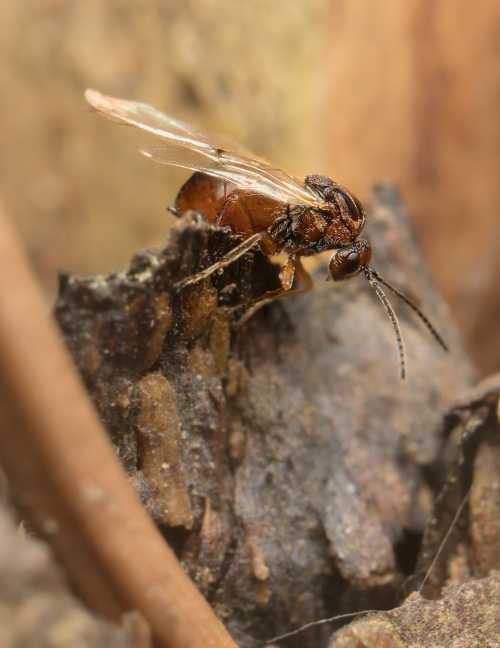 Gall wasp Andricus species
Gall wasp Andricus speciesGall Wasp Freeloaders And Cuckoos
Wasp galls can attract wasp inquilines1,2 - i.e. other wasp species that opportunistically take up residence inside the gall, along with the wasp larva.
Some of these inquilines apparently neither harm nor benefit the gall wasp larva. According to entomologist, Eric R. Heaton2, there are 186 wasp species that behave in this way, and they all belong to the Synergini tribe in the Cynipidae family.
Other inquilines will, however, kill the host in order to feed without competition.
Wasp galls also attract cleptoparasitoid wasps that kill the gall wasp larva. Strategies for invading and killing the host vary depending on species.
For example, the females of some crabonid wasps infiltrate the gall, lay an egg, and leave. The parasite larva will then hatch and kill the host offspring, thus removing competition for food.
Alternatively, some crabonid females enter a host gall, and destroy the egg of the host wasp before departing.
A further strategy can also occur. The parasite may wait until the host larva has finished eating, before attacking it.
Different types of wasp galls
Most people are familiar with two main types of gall found on oak trees, notably galls caused by the gall wasp, Cynips quercusfolii (see first image at the top of this page), and marble galls caused by galls wasps of the Andricus genus.
However, wasp galls are fascinating in variety of appearance.
Robin's Pincushion Gall
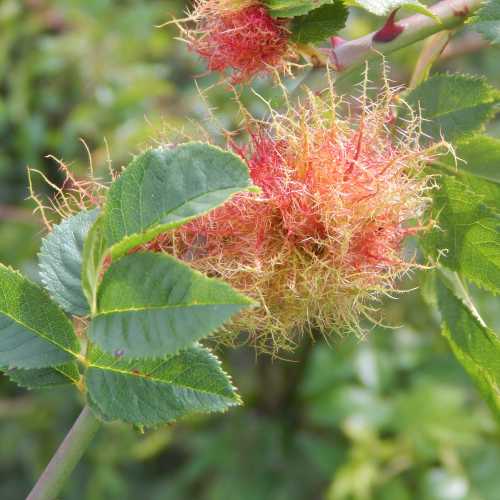 Robin's Pincushion galls caused by gall wasp Diplolepsis rosae
Robin's Pincushion galls caused by gall wasp Diplolepsis rosaeDuring a local walk, I took several pictures of Robin's Pincushion galls on a rose bush caused by activity of the Mossyrose Gall Wasp, Diplolepsis rosae.
These interesting, and even attractive galls look like balls of moss attached to rose stems. They are green in the summer, but are tinged with a lovely rusty brown to vibrant shade of red in the autumn.
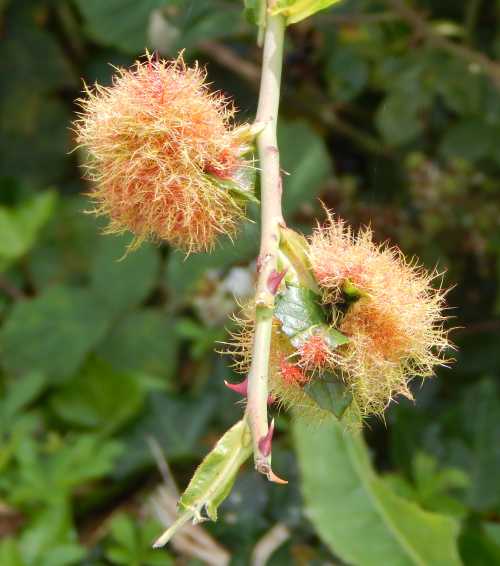
Diplolepis rosae over winter inside the galls as larvae or pre-pupae, and emerge as adults the next year in spring or early summer3.
Knopper Galls
Knopper galls are caused by the gall wasp Andricus quercuscalicis. This gall was named after the German word for a particular type of helmet, called a 'knopper'2. These wasp galls appear as a waxy green or vibrant red gall on the acorn fruits of oak trees (Quercus).
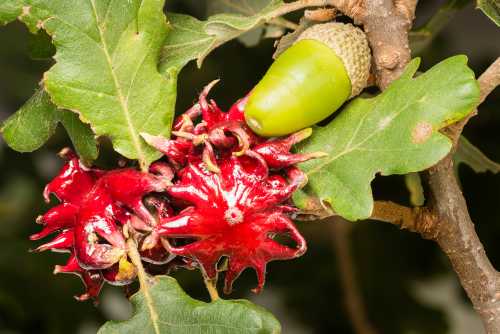 Knopper gall caused by Andricus quercuscalicis
Knopper gall caused by Andricus quercuscalicisSpangle Galls
Galls of the Spangle Gall Wasp (Neuroterus quercusbaccarum), are rather small and disc-shaped, but the underside of a leaf can host many galls. Each gall provides developing offspring with a protein and lipid-rich tissue centre, and a starchy outer4.
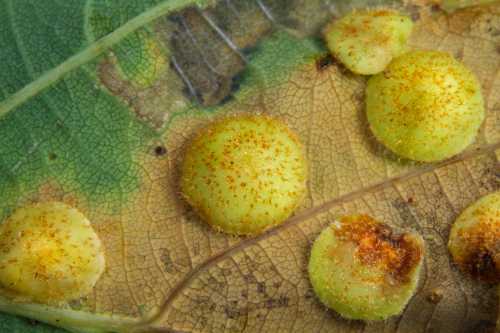 Common spangle galls of the wasp Neuroterus quercusbaccarum
Common spangle galls of the wasp Neuroterus quercusbaccarumWool-sower galls
Wool-sower galls are caused by wasp Callirhytis seminato and look like balls of cotton wool.
Closer inspection of wool-sower galls reveals pink seed-like material which serves to protect developing offspring of this wasp species.
The white oak, Quercus alba is the target host of the wool-sower gall wasp, Callirhytis seminato.
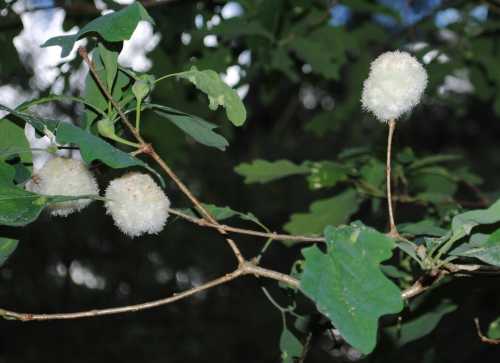 Wool-sower galls caused by wasp Callirhytis seminato
Wool-sower galls caused by wasp Callirhytis seminatoWoolly-leaf / Fuzzy Gall
The ‘wool-bearing’ or ‘fuzzy’ gall wasp, Andricus quercuslanigera is a native species in southern USA and Mexico5. It causes fuzzy-looking woolly galls on oak leaves.
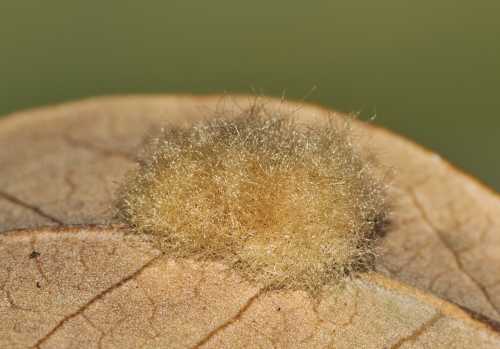 Woolly leaf gall caused by Andricus quercuslanigera wasp
Woolly leaf gall caused by Andricus quercuslanigera waspEach gall consists of 'wool' covering an inner capsule of mature galls on the underside of a leaf along mid-vein (these galls are rarely on topside of a leaf5).
References
1. Ronquist F, Nieves-Aldrey J-L, BuffingtonML, Liu Z, Liljeblad J, Nylander JAA (2015)Phylogeny, Evolution and Classification of Gall Wasps: The Plot Thickens. PLoS ONE 10(5):e0123301. doi:10.1371/journal.pone.0123301
2. Eric R. Heaton; Wasps – The Astonishing Diversity Of A Misunderstood Insect, Princeton University Press 2021.
3. Urban, Jaroslav. (2018). Diplolepis Rosae (L.) (Hymenoptera: Cynipidae): Development, Ecology and Galls in the Brno Region. Acta Universitatis Agriculturae et Silviculturae Mendelianae Brunensis. 66. 905-925. 10.11118/actaun201866040905.
4. Koncz, Nóra Kovácsné, László Szabó, Csaba Máthé, Katalin Jámbrik and Márta M-Hamvas. “Histological study of quercus galls of Neuroterus quercusbaccarum (Linnaeus, 1758) (Hymenoptera: Cynipidae).” (2011).
5. Glen R Hood, Linyi Zhang, Leah Topper, Pedro F P Brandão-Dias, Gaston A Del Pino, Mattheau S Comerford, Scott P Egan, ‘Closing the Life Cycle’ of Andricus quercuslanigera (Hymenoptera: Cynipidae), Annals of the Entomological Society of America, Volume 111, Issue 3, May 2018, Pages 103–113, https://doi.org/10.1093/aesa/say005
If you found this page helpful or interesting, I'd really be grateful if you would share it with others - if not this page, perhaps another, such as Gardening For Bees.
Thank you so much :) .
